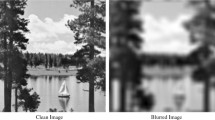Abstract
Ringing and noise amplification are the most dominant artifacts in image deconvolution. These artifacts can be reduced by introducing image prior into the deconvolution process. A regularization weighting factor can control the strength of regularization. Ringing and noise can be reduced significantly with the strong weighting factor, but details can be lost. We propose a non-blind image deconvolution method with adaptive regularization that can reduce ringing and noise in the smooth region and preserve image details in the textured region simultaneously. For adaptive regularization, we make a reference image that gives proper edge information and helps to restore a latent image. The reference image guides the strength of the weighting factor on the pixel of the blurred image. Experimental results show that ringing and noise are suppressed efficiently, while preserving image details.
Access this chapter
Tax calculation will be finalised at checkout
Purchases are for personal use only
Preview
Unable to display preview. Download preview PDF.
Similar content being viewed by others
References
Ben-Ezra, M.R., Nayar, S.K.: Motion Deblurring using Hybrid Imaging. In: Proceedings of Computer Vision and Pattern Recognition, vol. 1, pp. 657–664 (2003)
Fergus, R., Singh, B., Hertzmann, A., Roweis, S.T., Freeman, W.T.: Removing Camera Shake from a Single Photograph. ACM Trans. on Graph. (SIGGRAPH) 25, 787–794 (2006)
Yuan, L., Sun, J., Quan, L., Shum, H.Y.: Image Deblurring with Blurred/Noisy Image Pairs. ACM Trans. on Graph. (SIGGRAPH) 26, 1–10 (2007)
Shan, Q., Jia, J.Y., Agarwala, A.: High-quality Motion Deblurring from a Single Image. ACM Trans. on Graph. (SIGGRAPH) 27 (2008)
Krishnan, D., Fergus, R.: Fast Image Deconvolution using Hyper-Laplacian Priors. In: Advances in Neural Information Processing Systems, vol. 22, pp. 1–9 (2009)
Wiener, N.: Extrapolation, Interpolation, and Smoothing of Stationary Time Series. MIT Press, Cambridge (1964)
Lucy, L.: An Iterative Technique for the Rectification of Observed Distributions, vol. 79, pp. 745–754 (1974)
Donatelli, M., Estatico, C., Martinelli, A., Serra-Capizzano, S.: Improved Image Deblurring with Anti-reflective Boundary Conditions and Re-blurring. Inverse Problems 22, 2035–2053 (2006)
Dey, N., Blanc-Fraud, L., Zimmer, C., Kam, Z., Roux, P., Olivo-Marin, J., Zerubia, J.: Richardson-Lucy Algorithm with Total Variation Regularization for 3D Confocal Microscope Deconvolution. Microscopy Research Technique 69, 260–266 (2006)
Levin, A., Fergus, R., Durand, F., Freeman, W.T.: Image and Depth from a Conventional Camera with a Coded Aperture. ACM Trans. on Graph (SIGGRAPH) 26, 70–77 (2007)
Jia, J.: Single Image Motion Deblurring using Transparency. In: Proceedings of Computer Vision and Pattern Recognition, pp. 1–8 (2007)
Liu, R., Jia, J.: Reducing Boundary Artifacts in Image Deconvolution. In: IEEE International Conference on Image Processing (2008)
Osher, S., Rudin, L.I.: Feature-oriented Image Enhancement using Shock Filters. SIAM Journal on Numerical Analysis 27, 919–940 (1990)
Author information
Authors and Affiliations
Editor information
Editors and Affiliations
Rights and permissions
Copyright information
© 2010 Springer-Verlag Berlin Heidelberg
About this paper
Cite this paper
Lee, JH., Ho, YS. (2010). Non-blind Image Deconvolution with Adaptive Regularization. In: Qiu, G., Lam, K.M., Kiya, H., Xue, XY., Kuo, CC.J., Lew, M.S. (eds) Advances in Multimedia Information Processing - PCM 2010. PCM 2010. Lecture Notes in Computer Science, vol 6297. Springer, Berlin, Heidelberg. https://doi.org/10.1007/978-3-642-15702-8_66
Download citation
DOI: https://doi.org/10.1007/978-3-642-15702-8_66
Publisher Name: Springer, Berlin, Heidelberg
Print ISBN: 978-3-642-15701-1
Online ISBN: 978-3-642-15702-8
eBook Packages: Computer ScienceComputer Science (R0)




